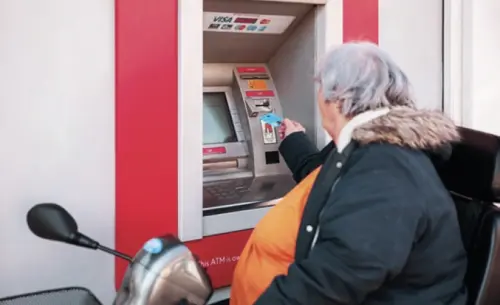6.2. Serving as a backstop for vulnerable consumers
Post offices are also more frequently used by vulnerable consumers. Nearly two in five vulnerable consumers use a post office once a month or more, compared to three in 10 consumers without a vulnerability characteristic, and vulnerable people are more likely to use their local post office at least once a month compared to those without a vulnerability characteristic. These results demonstrate that the universal reach of Post Office’s wide branch network is essential for those who are most vulnerable in our society.
Box 10
Case study: going above and beyond for the community in Rainhill
Post Office has always been a backstop for vulnerable and excluded groups across the UK and, as services increasingly move online, its role and in-person service has only grown more important for those either unable or unwilling to go online.
Beyond providing essential services, post offices often go above and beyond the call of duty in supporting vulnerable customers. Take Postmaster Sara Barlow, who runs Rainhill Post Office in Merseyside. Sara takes pride in helping vulnerable community members, including older people and people with disabilities.
After buying the post office and shop four years ago, Sara noticed some of her older customers were socially isolated and used their visits as an opportunity to check in and have a face-to-face interaction.
“We identified some customers as being vulnerable well before Covid, so we always give them a bit more time and call them to check in."
““If we haven’t seen someone for a while, we ask the neighbours to tell them we were asking for them, and then the customer comes in to say,"
“Thanks for asking after me”.
In addition, Sara’s post office had a few deaf customers. To make sure they were looked after, she taught her team some sign language so those customers could more easily access the services they needed.

“My uncle was deaf, so I can hold a conversation in sign. We taught the staff the basics and our deaf customers really appreciated it. We do little things like that.”
In particular, Sara’s role in helping vulnerable customers shone through in the pandemic. Within a fortnight of the first lockdown announcement, Sara had 85 volunteers on hand to support the community with shopping and essential deliveries.
“It was a big effort, but it was never planned. The post office was staying open, so it made sense.”
In 2021, Sara was awarded a British Empire Medal for her services to the community and was recognised by her local parish council as Citizen of the Year.
“The post office is a hub within the community. People need us here, and we need them as well.”
These findings are demonstrated by the difference in willingness-to-pay for vulnerable consumers to prevent their nearest post office from moving one mile further away. Vulnerable consumers were willing to pay around 50% more than non-vulnerable consumers to prevent their nearest post office from moving one mile away. The distance to the local post office branch was valued particularly highly by those with low capability measures (relating to whether the individual needs help with managing their finances, reading letters, etc.) and those experiencing poor health.
Vulnerable respondents also had a significantly higher valuation for the ability to pay bills at Post Office – a service that those in lower socio-demographic groups are more likely to rely upon. Those with low financial resilience placed the highest valuation on paying bills amongst any of the vulnerable groups, which is particularly striking given the financial difficulties the group faces. These findings again show how Post Office acts as a vital backstop for vulnerable individuals within local communities and individuals at risk of exclusion.